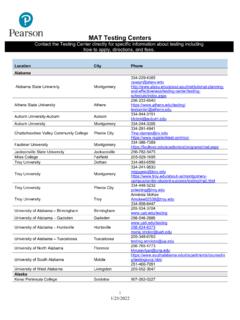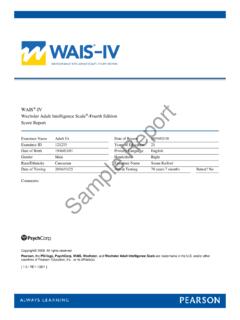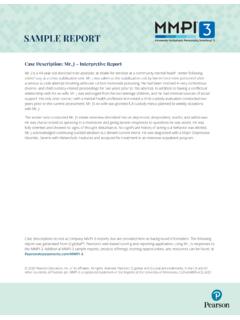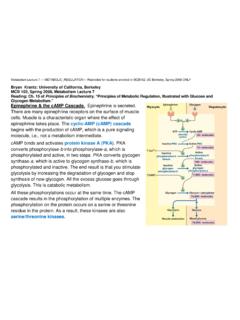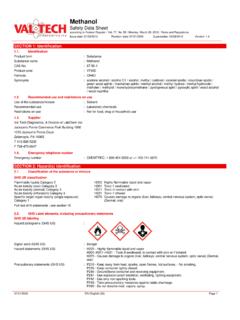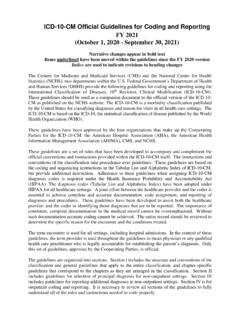Transcription of PCAT Test Blueprint and Sample Items - Pearson Assessments
1 PCAT Test Blueprint and Sample Items 1 Copyright 2019 NCS Pearson , Inc. All rights reserved. PCAT Test Blueprint and Sample Items Biological Processes Biological Processes Objectives B1. General Biology B2. Microbiology A. Cellular and Molecular Biology 1. Structure and functions of cells 2. Gene expression 3. Cell division and growth 4. Energy transformations 5. Metabolism A. Microorganisms B. Infectious Diseases & Prevention C. Microbial Ecology D. Medical Microbiology E. Immunity B3. Human Anatomy and Physiology B. Diversity of Life Forms 1. Genetics A. Structure 1. Cells 2. Tissues 3. Organs C. Health 1. Nutrition 2.
2 Diseases 3. Drugs B. Systems 1. Skeletal/muscular/nervous 2. Circulatory/respiratory 3. Excretory/digestive 4. Endocrine/reproductive 5. Integumentary/immune 6. PCAT Test Blueprint and Sample Items 2 Copyright 2019 NCS Pearson , Inc. All rights reserved. Examples of Biological Processes Items Biological Processes Items may be presented either standing alone (Biological Processes Examples 1 4) or associated with a short passage (Biological Processes Examples 5 8). Stand-alone Items can be answered independent of any passage or other item, while Items associated with a passage will require understanding part or all of the passage in order to answer them correctly.
3 Each Biological Processes item stem will be either in the form of a question (followed by a question mark) or in the form of an incomplete sentence that requires completion (with no end punctuation). Answer options may contain more than one concept or piece of information but each one will plausibly relate to the stem. In the following Sample Biological Processes Items , the correct answer for each item is followed by an asterisk (*), and each answer option is followed by a bracketed explanation for why it is correct (CA) or incorrect (neither of which will appear in the actual test). PCAT Test Blueprint and Sample Items 3 Copyright 2019 NCS Pearson , Inc.
4 All rights reserved. Biological Processes Example 1 Content Objective: Microbiology, Immunity Any foreign substance that triggers the formation of the lymphocyte immune response and is itself the target is called a(n) A. leukocyte. [A leukocyte is a white blood cell and not the target of an infection from a foreign molecule.] B. eosinophil. [Eosinophil is a type of white blood cell that is involved in the immune response to parasitic infections or allergic reactions and not the target of infection from a foreign molecule.] C. immunoglobulin. [Immunoglobulins are antibodies formed by B cells and not the targets of an infection from a foreign molecule.]
5 ] D. antigen. * [CA: Antigen is the correct term for anything that is the target of the immune response, causing production of antibodies by the living organism. Antigens can include foreign pollen, bacteria, viruses, proteins, and some other materials.] PCAT Test Blueprint and Sample Items 4 Copyright 2019 NCS Pearson , Inc. All rights reserved. Biological Processes Example 2 Content Objective: General Biology, Health, Diseases Which of the following conditions is caused by an impairment in the exchange of oxygen and carbon dioxide that is associated with emphysema? A. Respiratory alkalosis [Respiratory alkalosis is due to alveolar hyperventilation leading to decreased plasma carbon dioxide concentration.
6 It develops when the lungs remove more carbon dioxide than is produced in the tissues. It is a common finding in patients receiving medical ventilation, but it is not associated with emphysema, which results in a decreased expulsion of carbon dioxide.] B. metabolic alkalosis [This condition results from an altered metabolism. A decreased hydrogen ion concentration results in increased bicarbonate and carbon dioxide concentrations. It occurs most commonly when a person has been vomiting profusely. It is not associated with emphysema, which results in a decreased expulsion of carbon dioxide.] C. Respiratory acidosis * [CA: Respiratory acidosis is a clinical disturbance that is due to alveolar hypoventilation.
7 It results in low blood pH due to decreased clearance of carbon dioxide by the lungs. This condition occurs in emphysema as exhalation becomes insufficient.] D. metabolic acidosis [ metabolic acidosis is a condition in which the blood pH is low due to increased production of hydrogen ions by the body or the inability of the body to form bicarbonate in the kidney. It is not associated with emphysema, which results in a decreased expulsion of carbon dioxide.] PCAT Test Blueprint and Sample Items 5 Copyright 2019 NCS Pearson , Inc. All rights reserved. Biological Processes Example 3 Content Objective: General Biology, Diversity of Life Forms, Genetics DNA testing is performed for a child born with trisomy 21.
8 The test, using a polymorphic DNA marker for chromosome 21, revealed the pattern exhibited in the Southern blot below. Father Mother Child At which meiotic division did nondisjunction occur? A. Maternal meiotic division I * [CA: Nondisjunction is an error that can occur during meiosis or mitosis, causing the daughter cells to have too many or too few chromosomes. Because the child has two maternal alleles that are not identical and one paternal allele, nondisjunction occurred at this stage of division.] B. Paternal meiotic division I [If nondisjunction occurred here, the child would have two paternal alleles and one maternal allele.]
9 ] C. Maternal meiotic division II [If nondisjunction had occurred here, the maternal contribution would have been either no allele or two of the same kind.] D. Paternal meiotic division II [If nondisjunction had occurred here, the paternal contribution would have been either no allele or two of the same kind. Because there is only one of paternal origin, disjunction did not occur at this stage of division.] PCAT Test Blueprint and Sample Items 6 Copyright 2019 NCS Pearson , Inc. All rights reserved. Biological Processes Example 4 Content Objective: Human Anatomy and Physiology, Systems, Excretory/digestive Which sphincter in the gastrointestinal tract controls movement of chyme from the stomach into the small intestine?
10 A. Cardiac [The cardiac sphincter (lower esophageal sphincter) is located at the junction of the esophagus and the stomach.] B. Pyloric * [CA: The pyloric sphincter separates the stomach from the duodenum, the first division of the small intestine. The pyloric sphincter normally is in a contracted state, and retains food within the stomach until it has been broken down mechanically and chemically into chyme that can be passed into the duodenum of the small intestine.] C. Ileocecal [The ileocecal sphincter is located at the junction of the small intestine (ileum) and the large intestine.] D. Anal [The anal sphincter is located at the end of the rectum.]


